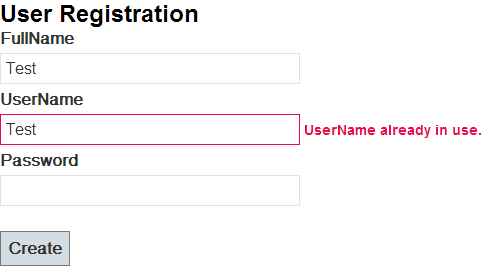Suggested Videos
Part 86 - ValidationSummary in asp.net mvc
Part 87 - What is Unobtrusive JavaScript
Part 88 - Unobtrusive validation
Sometimes, to check if a field value is valid, we may need to make a database call. A classic example of this is the user registration page. To register a user, we need a unique username. So, to check, if the username is not taken already, we have to make a call to the server and check the database table. RemoteAttribute is useful in situations like this.
Example: When a user provides a username that already exists, the associated validation error message should be displayed immediately as shown below.

Step 1: Create tblUsers table
Create table tblUsers
(
[Id] int primary key identity,
[FullName] nvarchar(50),
[UserName] nvarchar(50),
[Password] nvarchar(50)
)
Step 2: Create an ado.net entity data model using table tblUsers. Upon creating the entity model, change the name of the entity from to User. Save changes and build the solution.
Step 3: Add HomeController with the following settings
1. controller Name = HomeController
2. Template = MVC controller with read/write actions and views, using Entity Framework
3. Model Class = User (MVCDemo.Models)
4. Data context class = SampleDBContext (MVCDemo.Models)
5. Views = Razor
Step 4: Copy and paste the following function in HomeController. This is the method which gets called to perform the remote validation. An AJAX request is issued to this method. If this method returns true, validation succeeds, else validation fails and the form is prevented from being submitted. The parameter name (UserName) must match the field name on the view. If they don't match, model binder will not be able bind the value with the parameter and validation may not work as expected.
public JsonResult IsUserNameAvailable(string UserName)
{
return Json(!db.Users.Any(x => x.UserName == UserName),
JsonRequestBehavior.AllowGet);
}
Step 5: Right click on the Models folder and a class file with name = User.cs. Copy and paste the following code. Notice that the name of the method (IsUserNameAvailable) and the controller name (Home) and error message are passed as arguments to Remote Attribute
using System;
using System.Collections.Generic;
using System.Linq;
using System.Web;
using System.ComponentModel.DataAnnotations;
using System.Web.Mvc;
namespace MVCDemo.Models
{
[MetadataType(typeof(UserMetaData))]
public partial class User
{
}
public class UserMetaData
{
[Remote("IsUserNameAvailable", "Home", ErrorMessage="UserName already in use.")]
public string UserName { get; set; }
}
}
Step 6: Include references to the following css and script files in Create.cshtml view. jQuery, jquery.validate and jquery.validate.unobtrusive script files are required for remote validation to work.
<link href="~/Content/Site.css" rel="stylesheet" type="text/css" />
<script src="~/Scripts/jquery-1.7.1.min.js" type="text/javascript"></script>
<script src="~/Scripts/jquery.validate.min.js" type="text/javascript"></script>
<script src="~/Scripts/jquery.validate.unobtrusive.js" type="text/javascript"></script>
Step 7: Make sure ClientValidation and UnobtrusiveJavaScript are enabled in web.config
<add key="ClientValidationEnabled" value="true" />
<add key="UnobtrusiveJavaScriptEnabled" value="true" />

Part 86 - ValidationSummary in asp.net mvc
Part 87 - What is Unobtrusive JavaScript
Part 88 - Unobtrusive validation
Sometimes, to check if a field value is valid, we may need to make a database call. A classic example of this is the user registration page. To register a user, we need a unique username. So, to check, if the username is not taken already, we have to make a call to the server and check the database table. RemoteAttribute is useful in situations like this.
Example: When a user provides a username that already exists, the associated validation error message should be displayed immediately as shown below.

Step 1: Create tblUsers table
Create table tblUsers
(
[Id] int primary key identity,
[FullName] nvarchar(50),
[UserName] nvarchar(50),
[Password] nvarchar(50)
)
Step 2: Create an ado.net entity data model using table tblUsers. Upon creating the entity model, change the name of the entity from to User. Save changes and build the solution.
Step 3: Add HomeController with the following settings
1. controller Name = HomeController
2. Template = MVC controller with read/write actions and views, using Entity Framework
3. Model Class = User (MVCDemo.Models)
4. Data context class = SampleDBContext (MVCDemo.Models)
5. Views = Razor
Step 4: Copy and paste the following function in HomeController. This is the method which gets called to perform the remote validation. An AJAX request is issued to this method. If this method returns true, validation succeeds, else validation fails and the form is prevented from being submitted. The parameter name (UserName) must match the field name on the view. If they don't match, model binder will not be able bind the value with the parameter and validation may not work as expected.
public JsonResult IsUserNameAvailable(string UserName)
{
return Json(!db.Users.Any(x => x.UserName == UserName),
JsonRequestBehavior.AllowGet);
}
Step 5: Right click on the Models folder and a class file with name = User.cs. Copy and paste the following code. Notice that the name of the method (IsUserNameAvailable) and the controller name (Home) and error message are passed as arguments to Remote Attribute
using System;
using System.Collections.Generic;
using System.Linq;
using System.Web;
using System.ComponentModel.DataAnnotations;
using System.Web.Mvc;
namespace MVCDemo.Models
{
[MetadataType(typeof(UserMetaData))]
public partial class User
{
}
public class UserMetaData
{
[Remote("IsUserNameAvailable", "Home", ErrorMessage="UserName already in use.")]
public string UserName { get; set; }
}
}
Step 6: Include references to the following css and script files in Create.cshtml view. jQuery, jquery.validate and jquery.validate.unobtrusive script files are required for remote validation to work.
<link href="~/Content/Site.css" rel="stylesheet" type="text/css" />
<script src="~/Scripts/jquery-1.7.1.min.js" type="text/javascript"></script>
<script src="~/Scripts/jquery.validate.min.js" type="text/javascript"></script>
<script src="~/Scripts/jquery.validate.unobtrusive.js" type="text/javascript"></script>
Step 7: Make sure ClientValidation and UnobtrusiveJavaScript are enabled in web.config
<add key="ClientValidationEnabled" value="true" />
<add key="UnobtrusiveJavaScriptEnabled" value="true" />

How can i download the sample code which is using in video.
ReplyDeletesir ur video tutorials are excellent..when we r using remote validation in our application at time these remote validations are applicable to all the view in the given controller and when i am trying to edit the user at time it also shows me that username is already exists so my question is -
ReplyDeleteHow to disable remote validation for other views in my case for edit view???
Hi Sir,
ReplyDeleteFirst of all Thank you so much for you all videos, your just awesome. In Part 89 - Remote validation in asp.net mvc, we did validation to check whether user name is already exist or not. As you told if we disable javascript in browser its not working as expected. But my question here is if I make "false" to "UnobtrusiveJavaScriptEnableddfsdf" also its not working. Can you please explain it.
hi sir
ReplyDeleteplease can you upload MVC 5 related video
Hello sir
ReplyDeletesir kindly tell me how we return the JsonResult instead of bool if we go to the definition of Remote attribute so they implement the ValidationAttribute so if we return the bool i think no issue will hapen . my question is why we return the JSON result?
Jquery plugin need Json result to interpret.
DeleteWhat about edit page, in edit page remote validation is giving a erre already existing but it is wrong because user want to edit but after going edit form user change her mind and click on update button without any changes the he or she got error that is wrong
ReplyDelete????